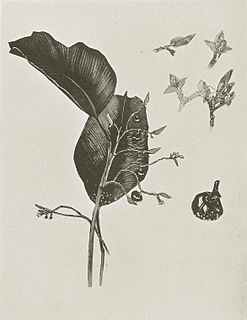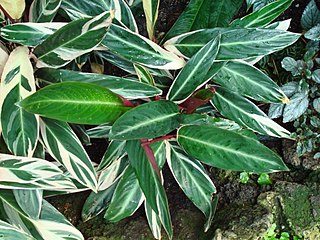
Maranta arundinacea, also known as arrowroot, maranta, West Indian arrowroot, obedience plant, Bermuda arrowroot, araru, araruta, ararao or hulankeeriya, is a large, perennial herb found in rainforest habitats. Arrowroot flour is now produced commercially mostly in St. Vincent and the Grenadines. Arrowroot was one of the earliest plants to be domesticated for food in northern South America, with evidence of exploitation or cultivation of the plant dating back to 8200 BC.

Violaceae is a family of flowering plants established in 1802, consisting of about 1000 species in about 25 genera. It takes its name from the genus Viola, the violets and pansies.

The Marantaceae are a family, the arrowroot family, of flowering plants consisting of 31 genera and around 530 species, defining it as one of the most species rich families in its order. Species of this family are found in lowland tropical forests of Africa, Asia, and the Americas. The majority (80%) of the species are found in the American tropics, followed by Asian (11%) and African (9%) tropics. They are commonly called the prayer-plant family and are also known for their unique secondary pollination presentation.

The plant tribe Phaseoleae is one of the subdivisions of the legume subfamily Faboideae, in the unranked NPAAA clade. This group includes many of the beans cultivated for human and animal food, most importantly from the genera Glycine, Phaseolus, and Vigna.

Calathea is a genus of plants belonging to the family Marantaceae. There are several dozen species in this genus. Native to the tropical Americas, many of the species are popular as pot plants due to their decorative leaves and, in some species, colorful inflorescences. They are commonly called calatheas or prayer plants.

Aechmea is a genus of flowering plants in the family Bromeliaceae. The name comes from the Greek aichme, meaning "spear". Aechmea comprises eight subgenera and around 250 species distributed from Mexico through South America and the Caribbean. Most of the species in this genus are epiphytes.

Rosmarinic acid is a chemical compound found in a variety of plants. It was found to exhibit photoprotective effect against ultraviolet C (UVC) damage when examined in vitro.

Renealmia is a plant genus in the family Zingiberaceae. Its members are native to tropical Africa and tropical America.

Sarcophrynium is a genus of plant in family Marantaceae indigenous to tropical Africa. It was described as a genus in 1902.

Ctenanthe oppenheimiana, the giant bamburanta or never never plant, is a species of flowering plant of family Marantaceae and is a native of Brazil. It is an evergreen perennial. The cultivar ‘Tricolor’ is an ornamental variety, which as a houseplant in the UK has gained the Royal Horticultural Society’s Award of Garden Merit.. This plant can grow to more than 1 m (3.3 ft) tall and broad, with long narrow leaves up to 40 cm (16 in) in length. These are dark green, heavily and irregularly marked with cream stripes, and wine-red on the undersides.

Thalia is a genus of six currently recognized species found in aquatic or marshy habitats, ranging in Africa from Senegal to Sudan to Zimbabwe, and in the Americas from Illinois to Argentina. Alligator-flag is a common name for plants in this genus. The generic name is in honor of Johannes Thal (1542–1583), a German doctor who wrote a Flora of the Harz Mountains.

Maranta leuconeura, also known as prayer plant, is a species of flowering plant in the family Marantaceae, native to the Brazilian tropical forests. It is a variable, rhizomatous perennial, growing to 30 cm (12 in) tall and broad, with crowded clumps of evergreen, strikingly-marked oval leaves, each up to 12 cm (5 in) long.
Halopegia is a genus of plants native to tropical Africa, Madagascar, and tropical southeast Asia. Three species are recognized as of April 2014:

Elettariopsis was a genus of plants in the ginger family, that has now been subsumed into the genus Amomum. Species are native to Southeast Asia, southern China and New Guinea.

Hornstedtia is a genus of plants in the Zingiberaceae. It is native to Southeast Asia, the Himalayas, southern China, New Guinea, Melanesia and Queensland.
Gagnepainia is a genus of plants in the ginger family, Zingiberaceae. It has three known species, all native to Indochina. All three were initially described in 1895 as members of Hemiorchis, then transferred to the newly created Gagnepainia in 1904.

Globba is a genus of plants in the ginger family. It contains about 100 species, native to China, the Indian Subcontinent, Southeast Asia, New Guinea, the Bismarck Archipelago and Queensland.

Mitracarpus is a plant genus in the coffee family Rubiaceae. Girdlepod is a common name for some species in this genus.
The anthophytes are a grouping of plant taxa bearing flower-like reproductive structures. They were formerly thought to be a clade comprising plants bearing flower-like structures. The group contained the angiosperms - the extant flowering plants, such as roses and grasses - as well as the Gnetales and the extinct Bennettitales.















